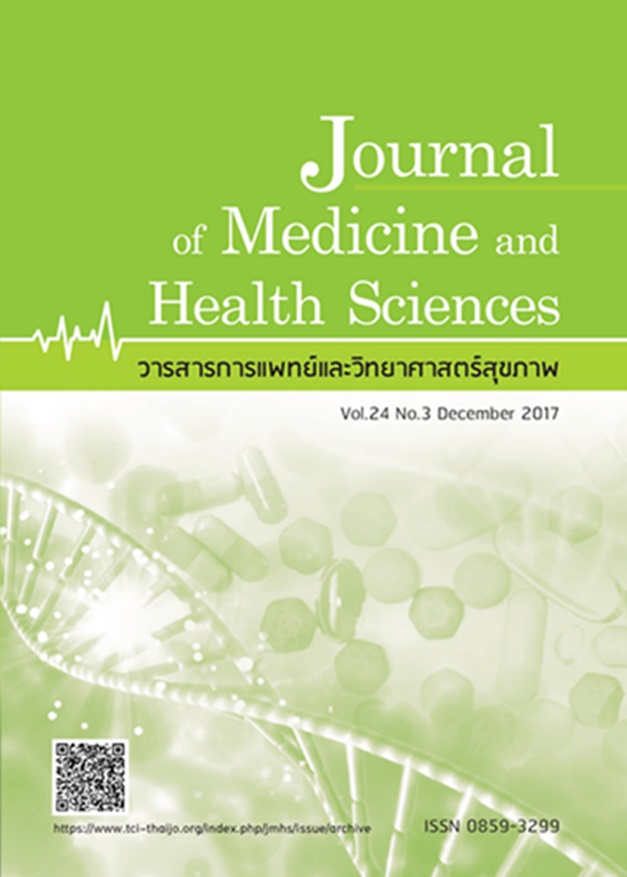การสร้างเครื่องมือวัดคุณภาพชีวิตที่เกี่ยวข้องกับสุขภาพประเภทสเกล
Keywords:
เครื่องมือวัดคุณภาพชีวิตที่เกี่ยวข้องกับสุขภาพประเภทสเกล การสร้างสเกล คุณภาพชีวิต, Health related quality of life scale, scale development, quality of lifeAbstract
องค์การอนามัยโลก ให้นิยามของคำว่าสุขภาพ คือ ภาวะที่สมบูรณ์ทางกาย ทางจิต และทางสังคม โดยมิได้หมายความถึงการไม่มีโรคและความไม่พิการ อีกทั้งคำนิยาม สุขภาพ ยังมีความหมายกว้างรวมถึงสภาพที่ดีของร่างกาย มีความแข็งแรงสมบูรณ์ ปราศจากโรคภัยไข้เจ็บ ร่างกายสามารถทำงานได้ตามปกติ และมีความสัมพันธ์กับทุกส่วนเป็นอย่างดี และก่อให้เกิดประสิทธิภาพที่ดีในการทำงาน ภาวะสุขภาพวัดได้โดยใช้ผลทางคลินิกหรือการตรวจทางห้องปฏิบัติการ บางครั้งมีการใช้เครื่องมือวัดคุณภาพชีวิตทางสุขภาพ วัดภาวะสุขภาพของผู้ป่วยเพื่อทำความเข้าใจเกี่ยวกับโรคและผลการรักษาที่ส่งผลต่อชีวิตของผู้ป่วยจากมุมมองของผู้ป่วย รวมถึงประเมินผลการรักษาและการดูแลของบุคลากรทางการแพทย์ และการติดตามดูแลผู้ป่วยทางคลินิก เครื่องมือที่นำมาใช้ควรมีการตรวจสอบความเชื่อมั่น เป็นที่ยอมรับในการวัด โดยเฉพาะผู้เชี่ยวชาญทางคลินิก และมีความไวต่อการเปลี่ยนแปลงต่อภาวะสุขภาพของผู้ป่วย คุณภาพชีวิตเป็นตัวชี้วัดความแตกต่างระหว่างความหวังและความคาดหวังของปัจเจกบุคคลและประสบการณ์ในปัจจุบันของแต่ละบุคคล คุณภาพชีวิตที่เกี่ยวข้องกับสุขภาพส่วนใหญ่เกี่ยวข้องกับปัจจัยที่อยู่ในขอบเขตของอิทธิพลของผู้ให้บริการด้านสุขภาพและระบบการดูแลสุขภาพ การวัดภาวะสุขภาพด้วยเครื่องมือวัดคุณภาพชีวิตที่เกี่ยวข้องกับสุขภาพ เป็นวิธีการวัดที่ครอบคลุมมิติด้านสุขภาพที่เกี่ยวข้องกับร่างกาย จิตใจ อารมณ์และโครงสร้างทางสังคม การพัฒนาเครื่องมือที่มีคุณภาพดีต้องผ่านหลายขั้นตอน และต้องได้รับการทดสอบเพื่อพิสูจน์ว่าเครื่องมือมีมาตรฐานที่ดีทั้งความตรงและความเที่ยง บทความนี้ได้กล่าวถึงขั้นตอนในการสร้างเครื่องมือวัดคุณภาพชีวิตที่เกี่ยวข้องกับสุขภาพประเภทสเกล รวมถึงสถิติวิเคราะห์ที่เกี่ยวข้อง
WHO defined health as a state of complete physical, mental and social well-being, and not merely the absence of illness or disablity. Health can be considered in terms of a person’s body structure and function and the presence or absence of disease or signs (health status); their symptoms and what they can and cannot do and the extent to which the condition affects the person’s normal quality of life. Health status can be measured using pathological and clinical measures and is usually observed by clinicians or measured using instruments. It is always best to use an existing measure which has been tried and tested rather than
inventing a new one. Use an existing standardised measure with proven reliability, validity and responsiveness is more practical. When evaluating the measures, psychometric criteria should be concerned. Quality of life is a measure of the difference between the hopes and expectations of the individual and the individual’s present experience. Health-related quality of life is primarily concerned with those factors which fall within the spheres of influence of health care providers and health caresystems. The measurement of health-related quality of life is best achieved and instrument that assesses the dimensions found to affect Health -related quality of life (HRQOL) HQOL and combines them into a single index. The process of forming such an instrument involves many steps, many of which are general to all tests. This paper reviews the literature and discusses the major issues regarding the development of a reliable, valid and practicable instrument that could comprehensively measure a patient’s q
References
and clinical research. Med Care 1989;
27(3 Suppl):S148-56.
2. W o r l d H e a l t h O r g a n i z a t i o n .
Study protocol for the World Health
Organization project to develop a
quality of life assessment instrument
(WHOQOL). Qual Life Res 1993;2(2):153-9.
3. Fayers PM, Machin D. Quality of Life:
assessment, analysis and interpretation.
2nd ed. West Sussex England: John Wiley
and Sons; 2013. p.3-27.
4. Priestman TJ, Baum M. Evaluation of
quality of life in patients receiving
treatment for advanced breast cancer.
Lancet 1976;1(7965):899-900.
5. Khiewyoo J. Alpha – coefficient.
Biostatistics Newsletters KKU 2009;1(1):2-3.
6. Wilkin D, Hallam L, Doggett MA. Measure
of need and outcome for primary health
care. 2nd ed. New York: Oxford University
Press;1993. p.1-301.
7. Coste J, Fermanian J, Venot A.
Methodological and statistical problems
in the construction of composite
measurement scales: a survey of six
medical and epidemiological journals.
Stat Med 1995;14(4):331-45.
8. Spector PE. Summated rating scale
c o n s t r u c t i o n : A n i n t r o d u c t i o n
(Quantitative applications in the social
sciences). New York: Sage; 1992. p.1-72.
9. Streiner DL, Norman GR, Cairney J.
Health Measurement Scales: A practical
guide to their development and use.
5th ed. Oxford: Oxford University Press;
2015. p.1-354.
10. DeVellis RF. Scale development : theory
and application. 2nd ed. New York: Sage;
2003. p.1-171.
11. Nunnally JC. Psychometric theory. 2nd
ed. New York: McGraw-Hill; 1978. p.245-46.
12. Khiewyoo J. Tool design and testing.
Khon Kaen: Khon Kaen University; 2005.
p.37-126.
13. Maurice JS, Ron DH, Peter MF. Quality of
life assessment in clinical trials: methods
and practice. Oxford: Oxford University
Press; 1998.
14. L y n n M R . D e t e r m i n a t i o n a n d
quantification of content validity. Nurs
Res 1986;35(6):382-6.
15. Sakthong P. Health related Quality
of life. Thai Pharm Health Sci J
2007;2(3):327-37.



